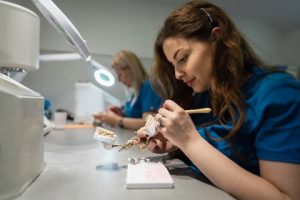 There are several vital roles in dentistry, each with a different emphasis. If you’re interested in the oral care field, there are career opportunities to match every interest and aptitude. For students with a passion for science and artistry, a job as a dental laboratory technician may be particularly rewarding. Let’s look deeper at this exciting occupation and what you’ll learn in a training program.
There are several vital roles in dentistry, each with a different emphasis. If you’re interested in the oral care field, there are career opportunities to match every interest and aptitude. For students with a passion for science and artistry, a job as a dental laboratory technician may be particularly rewarding. Let’s look deeper at this exciting occupation and what you’ll learn in a training program.
What Does a Dental Laboratory Technician Do?
Dental laboratory technicians create dental prosthetics and restorations, such as dentures, bridges, crowns, and veneers, based on specifications provided by a dentist. These custom-made appliances help restore oral function, improve aesthetics, and enhance patients’ overall health. It’s an expansive role. The work includes:
Material Selection
A quality dental appliance product requires appropriate materials. Dental technicians work with ceramics, metal alloys, acrylics, and resins, choosing suitable compounds based on strength, durability, biocompatibility, and appearance. The goal is to reproduce the patient’s natural teeth shape, size, and color.
Modeling and Waxing
Waxing and carving are steps in creating dental prosthetics of all kinds. Each involves using dental materials to sculpt replicas of restorations before they are cast or printed in the designated final material. Although they refer to different steps in the same process, waxing and carving are often used interchangeably in dental laboratory work.
Casting
Dental technicians cast metal alloys using specialized equipment, melting and injecting the metal and molding it into the desired shape for dental prosthetics involving metal components, such as crowns with metal posts.
Ceramic Layering
Ceramic layering, or porcelain build-up, is a technique dental laboratory technicians use to create the outermost layer of dental restorations. The purpose is to recreate the healthy appearance of natural teeth by applying layers of ceramic material onto a metal framework or high-strength ceramic core. After applying each layer, fire fuses the ceramic together to impart a natural translucence. The dental technician may add stains or glazes to enhance color and texture to optimize aesthetics.
Orthodontic Appliance Fabrication, Cleaning and Maintenance
Dental laboratory technicians may also create removable orthodontic appliances that aid in correcting jaw and tooth misalignment. Examples include retainers, splints, and aligners.
What Diploma or Degree Will Help Me Become a Dental Laboratory Technician?
There are several options to choose from so review each to determine which best fits your needs.
Diploma in Dental Laboratory Technology
Diploma programs in dental laboratory technology offer focused training in the skills required for entry-level positions. Offered by universities, full-time students can graduate in sixteen months. You will be out of the classroom and in the field quickly, making it a perfect option if you do not have years to dedicate to getting an education.
Associate Degree in Dental Laboratory Technology
Associate degree programs provide a more comprehensive education in dental technology. Available at universities, the curriculum includes dental technology and general education courses.
The associate degree in dental technology takes two years to complete. If you have the time, a degree program will provide a solid foundation for advanced roles in dental laboratories.
What Do You Learn in a Dental Lab Tech Associate Degree Program?
Intro to Prosthodontics Technology
In this introductory prosthodontics course, students learn to design, fabricate, and fit dental prostheses, such as dentures, crowns, bridges, and implants.
Students explore:
- Prosthodontics as a specialty
- The role of prosthodontics in restoring oral function, aesthetics, and comfort
- Impression techniques and materials
- Types of dental prostheses, including complete dentures, partials, crowns, and bridges
- The principles of prosthetic design and fabrication
Dental Anatomy
In dental anatomy, students study oral structures, including the teeth, gums, and oral tissues.
Topics include:
- Dental terminology
- Human permanent dentition
- Common dental anomalies and variations in tooth morphology
- Oral tissues, including the gingiva, alveolar bone, and oral mucosa
- Clinical crown morphology.
- Tooth numbering systems
- Dental occlusion and its significance in restorations
Intro to Full Dentures
Full dentures are prosthetic devices that replace all the teeth in the upper and/or lower dental arches.
This introductory course covers the following:
- The significance of dentures in restoring oral function and aesthetics
- Edentulous arch assessment and impression techniques
- Balanced occlusion
- Design principles for denture bases
- Processing techniques such as artificial tooth alignment, waxing, flasking, packing, curing, and de-flasking procedures
- Denture polishing and adjustment
Full Dentures Material
Students discuss:
- Denture materials
- Types of denture teeth
- Tooth selection and arrangement
- Shade selection
- Occlusion concepts and bite registration
- Finishing techniques to achieve a smooth and comfortable fit
- Denture maintenance, repair, and relining procedures
Full Dentures Clinic
This course provides hands-on training in working with dentures, bridging the gap between laboratory work and patient care.
You will practice:
- Pouring impressions
- Bite registration techniques
- Denture fittings and adjustments
- Infection control and safety principles
- Patient communication skills
- Professional collaboration and case management
Special Prostheses
Special prostheses include devices like immediate dentures, relines, and rebases.
Intro to Partial Dentures
Partial dentures are dental prostheses used to replace missing teeth when some natural teeth are still present.
This class explores:
- Types of partial dentures
- Design and fabrication techniques
- Partial base design
- Major and minor connectors in partial denture frameworks
- Tooth selection, molds, and arrangement for artificial teeth in partial dentures
Partial Design and Survey
This course covers the design and survey skills applicable to partial dentures.
Topics include:
- Surveying techniques used to assess the undercut areas around natural teeth
- Framework design for partial dentures
- Types of clasps used for appliance retention
- Occlusion considerations
- Designing partial dentures supported by dental implants
Partial Dentures Clinic
Like the full denture clinic, this course covers the techniques required to work with partials.
Students will:
- Practice pouring impressions
- Prepare bite registration plates and wax rims
- Fit and adjust partial dentures
Peter K. Thomas Functional waxing system. (PKT)
This class explores techniques for contouring and carving the wax patterns used for fabricating dental restorations.
Concepts include:
- The PKT technique and its significance in achieving lifelike ceramic restorations
- The properties of dental wax and handling techniques
- Wax pattern designs for dental restorations
- Creating texture and surface details
- Mastering natural light reflection
- Shade and color matching
Intro to Crowns and Bridges plus Materials
Crowns and bridges are fixed dental prostheses that restore damaged or missing teeth’ form, function, and aesthetics.
You will learn about:
- Crowns, bridges, and their role in restoring damaged or missing teeth
- Types of crowns and bridges
- Tooth preparation techniques for crown and bridge restorations
- Crown and bridge materials and fabrication
Crown and Bridge Clinic
Students in this course gain practical experience creating and fitting dental crowns and bridges.
Construction and Design of Working Casts and Dies
Working casts and dies are the foundation of PFM fabrications.
This course covers:
- Pouring dental stone or plaster into impressions to create working casts.
- Creating dies from working casts
- The use of die spacer materials
- Abutment teeth identification and margin trimming.
Intro to Marginal Design
Marginal design is a crucial step in fabricating well-fitting restorations.
Students get a comprehensive overview including:
- The clinical and aesthetic significance of accurate marginal design
- Marginal identification such as chamfer, shoulder, and featheredge
- Marginal trimming and finishing.
- Dental preparations and application of die sealers and spacers.
Introduction to Porcelain
Porcelain is widely used in dentistry for its natural appearance but requires excellent hands, skills, and finesse.
Students learn about:
- The physical and optical properties of porcelain
- Color theory and matching
- Porcelain layering techniques
- Porcelain firing
- Creating surface texture and characterization
- Contouring and incisal effects
- Stain and glaze application
Porcelain Crowns and Bridge Materials plus Clinic
This hybrid course covers the knowledge and skills you need to work with porcelain.
Topics include:
- Porcelain materials, felspathic and alumina ceramics.
- Porcelain properties and color characteristics
- Occlusal, functional, and aesthetic considerations
- Margin and finish line adaptations
Vacuum Porcelain Procedures
Vacuum porcelain procedures involve using vacuum technology to aid the porcelain layering and firing process for improved aesthetics, density, and fit.
Through hands-on exercises, students explore:
- Vacuum porcelain system.
- Vacuum porcelain layering techniques
- Dental porcelain stratification and characterization
- Stain and glaze application
Special Crown and Bridges Porcelain Prostheses
This class focuses on specialized restorations involving multiple units and complex aesthetic considerations.
An in-depth course that covers:
- Advanced porcelain techniques:
- Dental CAD CAM
- Different types of CAD CAM case materials.
– CAD Case entry
– CAD case scanning
– CAD case design
– CAM case printing or milling.
What Do You Learn During a Dental Laboratory Tech Diploma Program?
Diploma programs cover the same topics as associate degree programs but must be more in-depth. Introduction, material, and clinic courses are combined into a single course. Students spend less time in school but need to learn more on the job. The expectation is that graduates will take entry-level positions.
Final Thoughts
Oral care is an exciting and evolving field, but not every role requires filling cavities. If you prefer test tubes to toothbrushes, a career as a dental laboratory technician may be a perfect fit.
Eager to Learn More?
This Dental Laboratory Technician diploma program offers technical training and theory in Full and Partial Dentures and Crown & Bridge and Porcelain. Florida National University awards a diploma upon completion of the program.
This Dental Laboratory Technology Degree program offers technical training and theory in Full and Partial Dentures and Crown & Bridge and Porcelain. The program includes a fifteen-credit-hour component of general education/liberal arts courses. Students must demonstrate computer literacy before graduation; otherwise, the student must take a computer course. FNU awards an Associate of Science Degree upon graduation.
If you are interested in dental laboratory technology, let Florida National University answer any questions. Contact us today to learn more about our associate degree and diploma programs.



